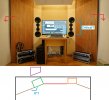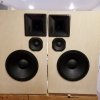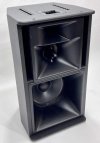I am interested to know more about your set up, because my room is a similar size and I like the idea of having LF woofers like that. I am currently looking in to the particulars of a single bass array, but I have questions about your config regardless.
View attachment 298272
These walls left and right of the speakers weren't planed first - they where needed to get rid of a side wall reflection I could not dampen with absorption. Can be removed, e.g. for testing and comparing speakers like KH120ii now. Normally you should build a pretty solid front wall but for my use these wood boards do the job.
The speakers are angled towards the listening position cause I sit pretty close. It would not be a big issue with the T25A but I wanted to use the T25B.
Btw only one of the 2,5" mid domes is active for listening, I needed both cause this speaker was also a prototype/concept for a measurement speaker.
Firstly, is the dimension between the woofers critical, or is that spacing just as close as possible to suit the drivers+boxes? Are the woofer boxes sealed or ported? What is the dark brown at the bottom of the right speaker stack (maybe packers to set the hieght)? Does the top of the top speaker reach the ceiling?
The LF drivers are as close to the mid drivers as possible - which is not the perfect position for the bass array! It still works with a little lower useable range. Sealed volumes cause I like the sound more, want to fill the volumes to have no resonances, want no port resonance and want to EQ down to 20/25Hz. The 4 20cm drivers are at their limit for loud listening with 20Hz content.
The speaker stacks are very solidly built with metal sheets internally against resonances - these 3 pieces are needed to carry them. The brown spacer is for getting the tweeter higher - I'm pretty big ;-), ear level is at 1m30 with my office chair. Speaker reach the ceiling.
Next I wonder about the actual layout. The front of the speakers looks toed in (judging by the floor lines), so like the green box below? Or is the angle part of the box, like the purple example? And is the angled wall the same angle as the angled speakers? Is there absorption material behind the angled walls?
When you use the "side walls" how the volume of the speaker is formed is not important. As I planed without them - the back of the speaker sits flat to the back wall. And the side wall next to the PC monitor goes straight back. The baffle of the speaker is angled and the outer side wall is too. I wanted to reach a good transition to the back wall, it would be beneficial to make that more flat, but harder to build.
There is some damping material behind - but in the next build step this will be made better with a more solid side wall, some 19" space below and an entrance for sound waves at the top.
Lastly, the monitor looks flush between the speakers, and the timber panel above it looks flush too. Is this flush to the ceiling? And is material behind it?
Yes - that's one of the key components of the design! Avoid reflecting corners, get everything flush and neat.
You always need to put some material behind cavities to avoid resonances in that volume. Especially if you want to dampen sound transition. But be careful with moisture when these are cold outside walls! (Yes - you need a pretty wide knowledge of stuff for that kind of installations ;-))
I did see other posts from you that showed how dead your room is, and that it doesn't suit everyone.
A non environment room is not a living room - it's made special for maximum precision at listening. Some people are sensitive to strongly dampened rooms, some for e.g have big problems in anechoic chambers. (ear & equilibrium & sickness in extreme cases). Therefor you have 2 reflective surfaces, the floor and the wall facing to you to still have a "feeling" for a room. But I had visitors who didn't liked the feeling in the room in the first minutes.
You get used to that quickly - I don't recognise it any more, but I'm also used to work in an anechoic chamber. For me it has a very calming character - it's dead silent and no influence from the outside. A floating tank for every day ;-)
Interestingly my mixes/masterings translate in that room better as ever. Even when it's acoustically total different to a normal living room - you hear what your source gives you. And people are used to the colouration of their room, so you need a "neutral" recording - and that's something you can produce/check in such a room perfectly.
The only thing I give my speakers a bass boost cause that's how most people listen in their rooms. Without I tend to overdo the low frequency area.
You ALWAYS can bring reflections back in to a controlled room! A few wooden pannels/beams with spacings, angled whatever (picture on alubond?) or a nice diffusor and you can create a more lively zone. This is often done in bigger control rooms ("reflection free zone" design) but in a small room you need to be very careful to not get too early reflections!
People confuse "dead" rooms with "dull" rooms cause you never eperience a really good and linear dampened room outside of a good studio. My recording room has the ceiling and long wall totally dampened - and has a fresh character with lots of top end, just very short "reverb". Feels great and works great for recording.
In the handfull rooms I designed we always leave the option to put something on the walls to get reflections back - nobody ever used that option.
(I have a wooden beam around my recording room where I could hang wooden/metal panels to have variation during recordings. Never needed but it's also great to hang guitars there ;-))
Hope that was not too off topic and I got most of your points

Btw - when digging deeper 1-2 books about studio acoustics and building are the best investment you can do!




